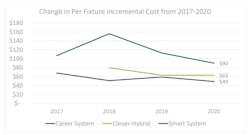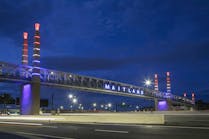NEEA study reveals cost adder of clever and smart connected SSL
The Northwest Energy Efficiency Alliance (NEEA) recently released research conducted by Energy Solutions that examined the true cost of adding connectivity and controls to an LED-based luminaire at the individual luminaire level. The report entitled “2020 Luminaire Level Lighting Controls Incremental Cost Study” was based on input from 16 solid-state lighting (SSL) manufacturers or representatives focused on clever or smart lighting in 19 typical project scenarios. The cost adder can vary $50–$100 per fixture based on the level of intelligence in a product, but that premium has dropped 15–30% relative to research conducted four years ago.
Since we first covered connected and smart lighting a decade ago, the focus has always centered on how to pay for such functionality. All of the way back in 2010, startup Digital Lumens (now an Osram business unit) proclaimed its connected LED lighting in warehouses and other industrial applications could yield 90% in energy savings and therefore a guaranteed return on investment (ROI). Over the course of the last decade, connectivity schemes and smart-lighting application concepts have expanded considerably in concept, with many expecting improved employee productivity becoming the ultimate ROI driver. We first wrote about what is called the 3-30-300 rule after a European conference back in 2017.
Still, what would have the biggest impact on ROI would be lower costs for adding and utilizing connectivity in each luminaire. The cost premium includes both the hard cost of additional sensors/controllers/communication devices in each luminaire and the cost of installation/commissioning/programming. That latter bucket includes the time people spend doing work and perhaps the cost on infrastructure such as wired or wireless gateways that link to an SSL installation.
The NEEA has sought to fully document such costs. And doing so first required a precise methodology of characterizing the level of intelligence or capability in a luminaire. The research states that a “clever” luminaire is one with occupancy and ambient-light sensors, basic connectivity, and that meets DesignLights Consortium (DLC) specifications. These clever systems are intended to be close to plug-and-play in terms of installation and programming.
The research defined “smart” luminaires as those that can work in an Internet-of-Things (IoT) setting allowing informed decision making on things such as control of an HVAC system or asset tracking using beacons, for instance in a retail or medical environment. Subsequently, the research team recognized the need for an interim class of luminaires that function between the smart and clever levels, in part because of emerging interest in such products. The “clever-hybrid” category was defined to include luminaires that do communicate with a gateway and have basic energy-monitoring capabilities but that lack full IoT functionality.
The NEEA has been tracking the evolution of such luminaire-level controls going back to 2017. The nearby graph depicts the trend of the cost premium over four years relative to a luminaire without local controls. The data shows that controls costs are now at the lowest adder over the four years.
Having captured the cost information and modeled the cost of installation, gateways, programming, and more, the researchers projected scenarios involving a 40,000-ft2 office building in which 471 luminaires would be installed. The report didn’t detail the baseline cost of a project without luminaire level controls, but our calculations show that the total project cost would have been $47,100 or $1.18/ft2.
A clever system on average would increase the cost to $70,010 or $1.75/ft2, a clever-hybrid to $74,069 or $1.85/ft2, or a smart to $220,701 or $2.21/ft2. The big jump to the smart system is caused by the need for gateways, servers, and increased programming complexity. The clever systems only had incremental configuration costs of $1–$2.
Of course, there are two things missing from the picture painted by the NEEA study. One is a detailed look at the ROI of each scenario. And the second is confirmation that the projections of installation, gateways, programming, and more is accurate.
The NEEA research based its numbers on data provided by the manufacturers or their representatives that should indeed have experience with the technology platform in question and that should not struggle with coaxing connected SSL to function as intended. But as we have reported, even experienced lighting professionals can struggle to get such systems to work properly. We published a feature article last year authored by experts at the Department of Energy (DOE) Pacific Northwest National Laboratory (PNNL) that documented such difficulties.
You can peruse the details of the NEEA work on the organization’s website.
For up-to-the-minute LED and SSL updates, why not follow us on Twitter? You’ll find curated content and commentary, as well as information on industry events, webcasts, and surveys on our LinkedIn Company Page and our Facebook page.

Maury Wright | Editor in Chief
Maury Wright is an electronics engineer turned technology journalist, who has focused specifically on the LED & Lighting industry for the past decade. Wright first wrote for LEDs Magazine as a contractor in 2010, and took over as Editor-in-Chief in 2012. He has broad experience in technology areas ranging from microprocessors to digital media to wireless networks that he gained over 30 years in the trade press. Wright has experience running global editorial operations, such as during his tenure as worldwide editorial director of EDN Magazine, and has been instrumental in launching publication websites going back to the earliest days of the Internet. Wright has won numerous industry awards, including multiple ASBPE national awards for B2B journalism excellence, and has received finalist recognition for LEDs Magazine in the FOLIO Eddie Awards. He received a BS in electrical engineering from Auburn University.





